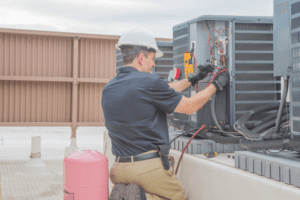Are you trying to decide what type of heating system is right for your commercial building? The first and most obvious option available to you is the traditional forced air HVAC system. In most commercial buildings, a roof-mounted HVAC system circulates heated or cooled air throughout the building via ductwork. However, you also might consider commercial radiant heating systems, which use an entirely different method to distribute warmth throughout a building.
What Is Radiant Heat?
 Radiant heat systems achieve warmth in an area by heating panels or tubes in the floors of a room. Since heat rises, the warmth produced by the radiant system then “radiates” throughout the rest of the room. Some radiant heating systems also supply heat via panels in the walls. Infrared radiation allows the heat to transfer from the floor to the people and objects occupying the room or space.
Radiant heat systems achieve warmth in an area by heating panels or tubes in the floors of a room. Since heat rises, the warmth produced by the radiant system then “radiates” throughout the rest of the room. Some radiant heating systems also supply heat via panels in the walls. Infrared radiation allows the heat to transfer from the floor to the people and objects occupying the room or space.
The concept of radiant heat is far from new. On the contrary, the ancient Greeks and Romans used this type of heating system in their buildings thousands of years ago. When you are standing a few feet away from a hot oven or stove but can still feel the heat, what you are feeling is a form of radiant heat. Despite the timeless nature of this type of heat, though, both residential and commercial radiant heating systems are gaining popularity and being talked about almost as a new technology.
The term “radiant heat” refers to the way the heat from these systems transfers from the heating element itself to the people and objects in a room. The process behind radiant heat, meanwhile, can be achieved through various different means. Radiant heat systems come in a few different variations, each of which uses a different method to heat the panels or tubes in the floor. The most common types of radiant heat systems are electric systems and hydronic systems.
Electric systems, as their name implies, use electricity to heat cables in the floor. These cables or coils then radiate heat up through the floor and into the room above. In most cases, you won’t always need to keep a steady flow of electricity to these heating panels. Instead, you can charge the panels overnight, during off-peak electricity hours. From there, the charged radiant floor system can provide heat for hours at a time. Unless it is an unusually cold day, the system probably won’t need to draw any additional electricity until its nighttime recharge.
Hydronic radiant systems, meanwhile, use water to provide heating solutions. In these systems, a boiler heats the water and then pumps it through tubes in the floor. The heating tubing then heats the room in the same way that the cables in an electric system do. Hydronic systems tend to be the most cost-effective, efficient, and popular type of radiant heat systems.
The Pros and Cons of Commercial Radiant Heating Systems
As with any heating system, there are advantages and disadvantages to using radiant heat in your building. On the pros side, radiant heating systems don’t use forced air to heat a space, which means they aren’t as drying as traditional HVAC systems. They also offer a very cozy and comforting type of heat that feels natural in a way that forced air heat might not always feel. Finally, radiant heat systems (at least, when designed and built correctly) are the most energy-efficient way to heat a space.
As for cons, radiant heat has those as well. The big obstacle—especially on a commercial level—is expense. Radiant heating systems are markedly more expensive to install than other types of heating systems. Switching an entire building over to radiant heat will cost much, much more than merely replacing the existing HVAC system. Even planning from the beginning and building your business with radiant heat in mind, you will spend a lot more money on this type of system than you would just putting in ducts for HVAC.
With radiant heat, air temperatures are also typically lower than with HVAC systems. You will feel the comforting warmth of the system after you enter a room, but the space might feel a little chilly when you enter. Radiant heat systems are also not as agile as HVAC systems, which means it will take longer to lower or raise room temperatures if you need to do so. In general, you will have less temperature control if you opt for radiant.
Finally, radiant heating systems don’t always have a cooling counterpart in the way that air conditioning comes as part of commercial HVAC systems. Though radiant cooling systems do exist, they require additional equipment and add further to the cost of the system. As such, if you choose radiant heat, you will need to plan for this extra expense—whether you decide to go with radiant cooling or an external air conditioning system.
Conclusion
While commercial radiant heating systems are certainly growing more and more popular, forced air HVAC systems remain the go-to option in this space. To learn whether radiant heating and cooling might be a practical option for your business, consult with your HVAC professional.

